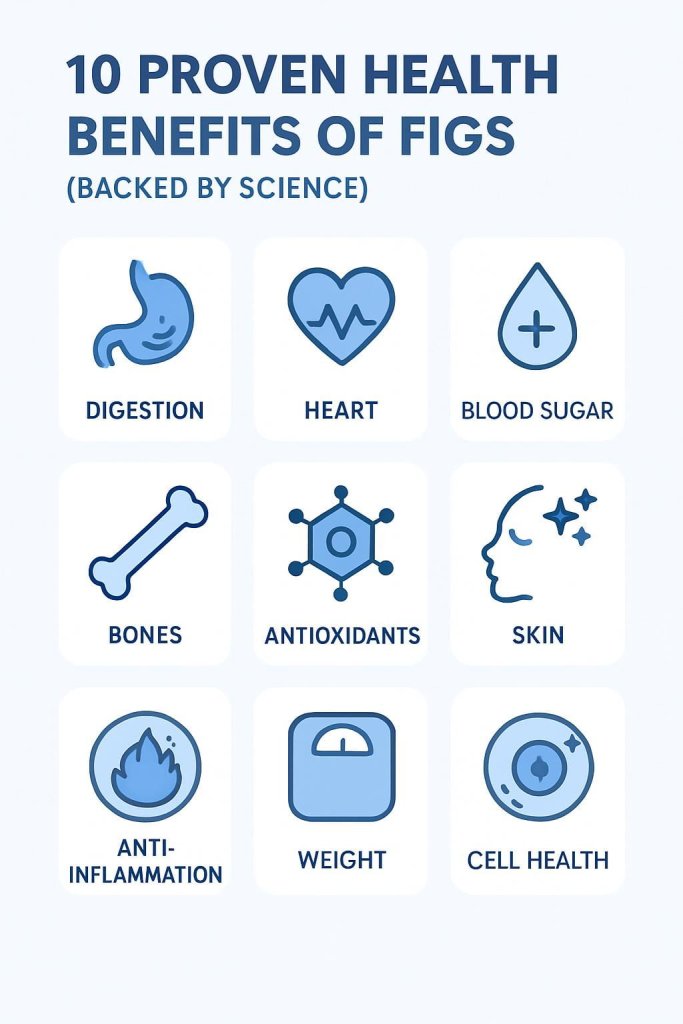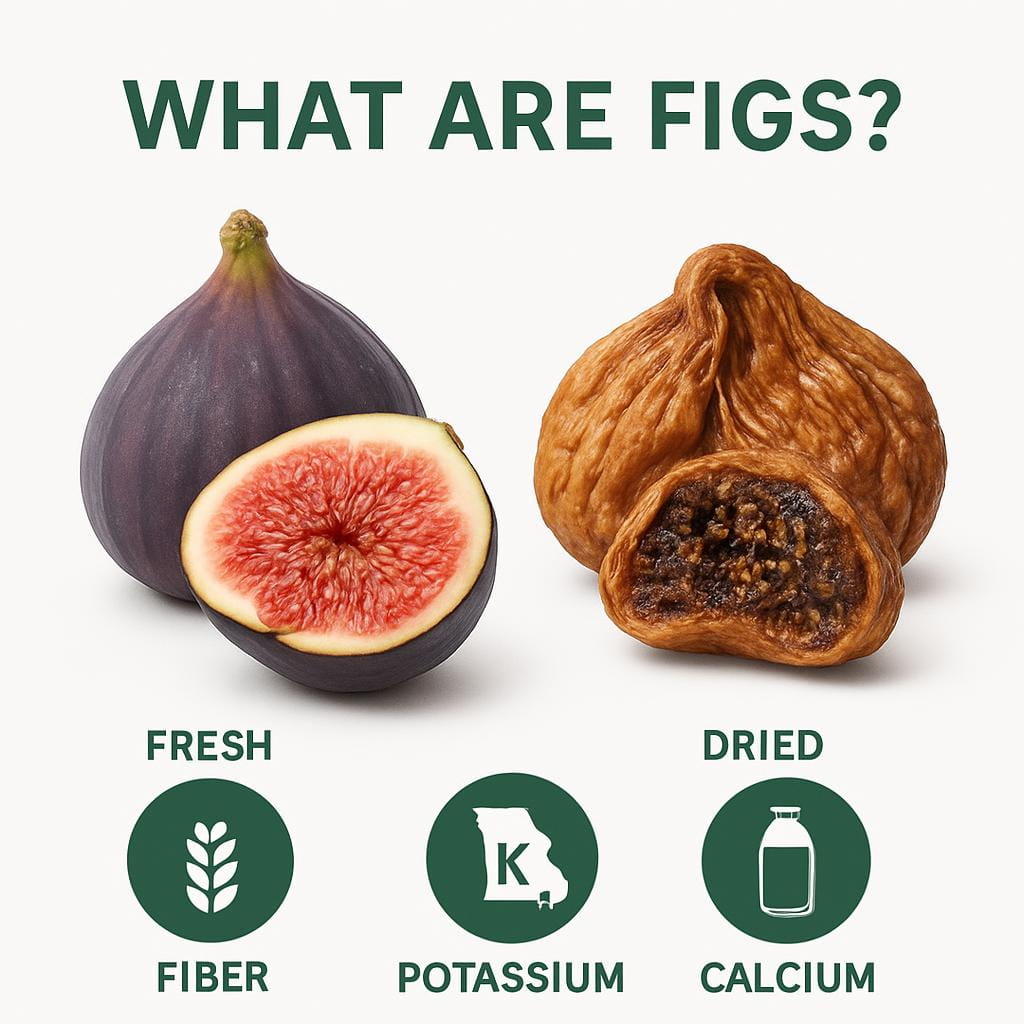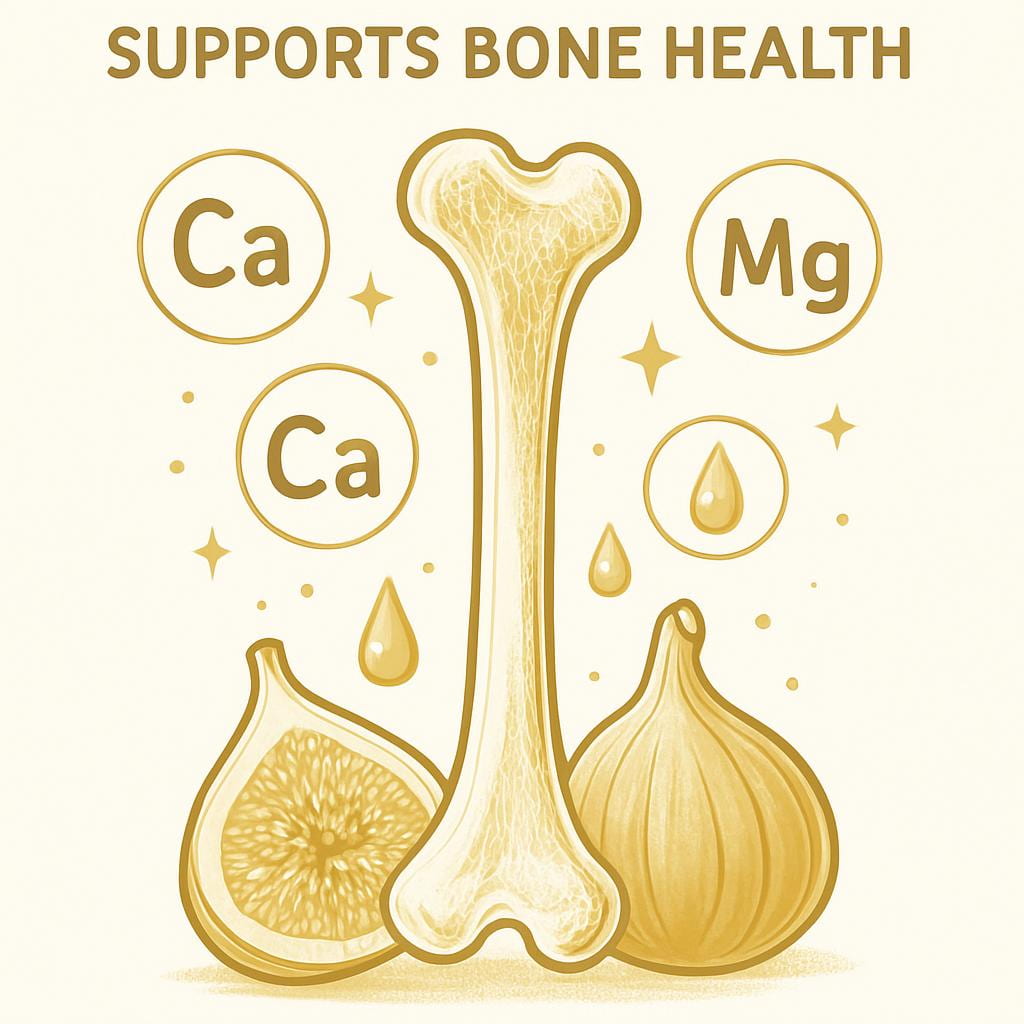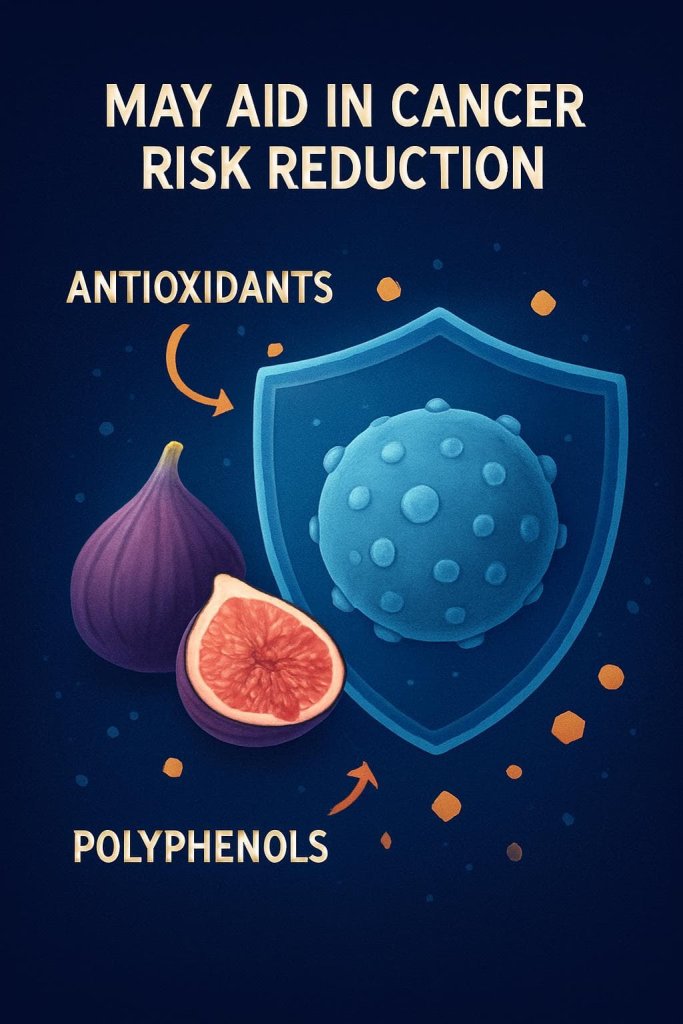Figs are nutrient-dense fruits that may support digestive health, heart function, and overall wellness.
Known scientifically as Ficus carica, figs have been enjoyed since ancient times for their natural sweetness and rich nutritional value. Whether eaten fresh or dried, they provide fiber, potassium, calcium, magnesium, and antioxidants that contribute to better digestion, blood pressure balance, and bone strength.

Understanding the health benefits of figs is important because they’re more than just a sweet snack — they’re a source of compounds that support gut health, regulate metabolism, and provide essential micronutrients vital for daily function.
In this article, you’ll discover the 10 proven, science-backed health benefits of figs, how to include them in your diet, safe storage and serving tips from the USDA and FDA, and what precautions to consider if you have food allergies or sensitivities.
What Are Figs? (Overview and Nutrition Profile)
Figs (Ficus carica) are soft, sweet fruits from the mulberry family (Moraceae), widely grown in Mediterranean, Middle Eastern, and subtropical regions. They have been cultivated for thousands of years and are prized for both their natural sweetness and impressive nutrient composition.
Fresh figs have smooth, edible skin and a seedy, jam-like center, while dried figs are dehydrated versions that concentrate nutrients, fiber, and natural sugars. Today, popular varieties include Black Mission, Kadota, Brown Turkey, and Adriatic figs, each offering a slightly different flavor and texture.
According to the U.S. Department of Agriculture (USDA) FoodData Central, figs are low in fat and sodium, naturally cholesterol-free, and provide beneficial amounts of fiber, potassium, magnesium, calcium, iron, and antioxidants such as polyphenols and flavonoids.

Nutritional Profile of Figs (per 100 g)
| Nutrient | Fresh Figs | Dried Figs | Key Health Role |
|---|---|---|---|
| Calories | 74 kcal | 249 kcal | Energy & satiety |
| Carbohydrates | 19.2 g | 63.9 g | Natural energy source |
| Dietary Fiber | 2.9 g | 9.8 g | Supports digestion & gut health |
| Protein | 0.75 g | 3.3 g | Tissue repair |
| Potassium | 232 mg | 680 mg | Blood pressure regulation |
| Calcium | 35 mg | 162 mg | Bone and dental health |
| Magnesium | 17 mg | 68 mg | Muscle and nerve function |
| Iron | 0.37 mg | 2.03 mg | Oxygen transport |
| Vitamin K | 4 µg | 15 µg | Bone metabolism & blood clotting |
| Water | 79% | 30% | Hydration & freshness |
Source: USDA FoodData Central – Figs, Raw and Dried
Figs also contain bioactive compounds such as anthocyanins, quercetin, and chlorogenic acid, which act as antioxidants to help combat oxidative stress.
A review in Nutrients (2023) highlighted that both fresh and dried figs contribute to metabolic health, digestive comfort, and cardiovascular support, thanks to their diverse phytochemical content (PubMed – Phytochemical Composition and Health Benefits of Figs).
Quick Nutrition Insight
- Fresh figs are lower in calories and sugar, ideal for daily snacks.
- Dried figs are nutrient-dense but higher in natural sugars—best enjoyed in moderation.
- Their fiber-to-calorie ratio makes figs an excellent fruit for digestive and heart health.
10 Proven Health Benefits of Figs (Backed by Science)
Figs (Ficus carica) are among the oldest cultivated fruits, valued for their sweet flavor and impressive nutrient density. Modern research highlights that figs may help support digestive, cardiovascular, bone, and metabolic health when consumed as part of a balanced diet. Below are ten science-backed benefits that contribute to overall wellness.
1. Promotes Digestive Health

Figs are a rich source of soluble and insoluble dietary fiber, which supports healthy bowel movements and overall gut balance. According to a 2022 study published in Nutrients, adults with constipation who consumed 45 g of dried figs twice daily experienced better stool consistency and less discomfort than a control group (Nutrients, 2022).
The fiber in figs also acts as a prebiotic, feeding beneficial gut bacteria that influence digestion and immune health. Regular consumption may therefore support a more diverse microbiome, improving nutrient absorption and intestinal comfort.
Learn more from the Cleveland Clinic – Benefits of Figs.
2. Supports Heart Health and Blood Pressure

Figs contain key nutrients such as potassium, magnesium, and antioxidants that help maintain normal blood pressure and vascular function.
Potassium helps counteract the effects of sodium, which may reduce the risk of hypertension. Additionally, polyphenols and flavonoids in figs support blood vessel elasticity and help neutralize oxidative stress associated with cardiovascular disease.
Animal studies also show that fig leaf extract may reduce triglyceride levels and improve lipid balance — indicating a potential supportive role in heart health (WebMD – Health Benefits of Figs). Including figs with other heart-friendly foods such as oats, leafy greens, and olive oil may further promote cardiovascular wellness.
3. Helps Maintain Healthy Blood Sugar Levels

Despite their natural sweetness, figs may help balance blood sugar levels when consumed in moderation. Their high fiber content slows glucose absorption, leading to steadier post-meal sugar levels and reduced insulin spikes.
A small human trial observed that drinking fig leaf tea lowered insulin needs in people with type 1 diabetes, suggesting possible benefits for glucose regulation (Healthline – Figs: Nutrition, Benefits, and Downsides).
To support healthy blood sugar, choose fresh figs over heavily processed varieties, watch portion sizes, and pair them with protein or fat (like yogurt or nuts) for balanced energy release.
4. Supports Bone Health

Figs are a natural source of calcium, magnesium, and potassium, minerals essential for bone formation and density. A diet rich in potassium has been shown to help reduce calcium loss from bones and support long-term skeletal strength.
Though human research is limited, laboratory findings indicate that fig extracts may protect against bone loss and oxidative damage by reducing inflammation and free-radical activity.
Learn more from Medical News Today – Figs: Benefits and Nutrition.
Combining figs with other bone-supportive nutrients — such as vitamin D and protein — and engaging in weight-bearing exercise can further enhance bone health.
5. Provides Antioxidants and Reduces Oxidative Stress

Figs are loaded with polyphenols, flavonoids, and carotenoids that act as antioxidants, protecting cells from oxidative stress and inflammation.
A 2023 review published in Nutrients confirmed that both fresh and dried figs possess high antioxidant capacity and may help mitigate cellular damage linked to aging and chronic disease (PubMed – Phytochemical Composition and Health Benefits of Figs).
Including figs with other antioxidant-rich fruits — such as berries, grapes, and citrus — enhances total dietary antioxidant intake and supports long-term metabolic health.
6. May Support Skin and Hair Health

Figs contain nutrients and antioxidants that may support skin elasticity, collagen production, and healthy hair growth. They provide small amounts of copper and iron, which are essential minerals for tissue repair and circulation. According to the National Institutes of Health (NIH) – Copper Fact Sheet for Health Professionals, copper plays a vital role in forming collagen and elastin, two key proteins that maintain skin firmness and structure.
Iron supports oxygen delivery to hair follicles, which may promote stronger hair and reduce shedding in individuals with low iron status. The Harvard T.H. Chan School of Public Health – The Nutrition Source notes that iron deficiency can contribute to fatigue, brittle nails, and hair loss if left unaddressed.
Emerging research also suggests fig-derived compounds may help soothe and hydrate skin. A 2022 clinical study published in the Journal of Clinical Medicine found that a cream containing Ficus carica fruit extract improved skin barrier function and hydration in participants with mild dermatitis. Researchers attributed these effects to figs’ natural polyphenols and vitamins, which help reduce dryness and irritation.
While more studies are needed, incorporating figs into a balanced, nutrient-rich diet may help support skin appearance and overall wellness naturally. For individuals with eczema or sensitive skin, consult a dermatologist before using any fig-based topical products.
7. May Help Reduce Inflammation

Figs naturally contain anti-inflammatory compounds that may modulate cytokines — molecules responsible for immune signaling and inflammation.
Chronic, low-grade inflammation contributes to the progression of conditions such as heart disease, type 2 diabetes, and arthritis.
Adding figs to a diet rich in anti-inflammatory foods (like olive oil, leafy greens, turmeric, and berries) may support systemic balance.
For more information on inflammation and diet, visit the Harvard T.H. Chan School of Public Health – Inflammation and Diet.
8. May Support Healthy Weight Management

Figs’ dietary fiber increases satiety, helping to reduce overeating and improve appetite control. Fresh figs are low in calories, while dried figs, though calorie-dense, provide a satisfying alternative to processed sweets when portioned correctly.
Fiber also supports blood sugar stability, which can help reduce cravings.
Tip: Pair figs with protein or healthy fats — like almonds or Greek yogurt — for balanced energy and prolonged fullness.
For more on smart snacking, see Health.com – Health Benefits of Figs.
9. May Aid in Cancer Risk Reduction (Preliminary Evidence)

Emerging research suggests that certain bioactive compounds in figs, such as benzaldehyde and ficin, may inhibit cancer cell proliferation in laboratory studies. These compounds exhibit antioxidant and anti-inflammatory actions that could potentially reduce cellular stress.
However, this evidence remains preclinical, and no human studies confirm a cancer-preventive effect. The best approach is to consume figs as part of a plant-forward diet rich in fruits, vegetables, whole grains, and legumes, which collectively support cellular defense systems.
See the review on ResearchGate – Phytochemical Composition and Health Benefits of Figs.
10. May Enhance Circulation and Reproductive Wellness

Figs have long been associated with reproductive vitality in traditional diets due to their mineral and antioxidant content.
Modern studies in animal models show that fig extracts may enhance blood vessel function and increase nitric oxide production, improving circulation — a factor linked with both cardiovascular and reproductive wellness.
Although more human research is required, these findings align with the general cardiovascular benefits of polyphenol-rich fruits.
Learn more from the Cleveland Clinic – Benefits of Figs.
How to Eat Figs for Best Results

Figs are versatile, nutrient-rich fruits that can be enjoyed fresh or dried in both sweet and savory dishes. Incorporating them into your diet in moderation may help support digestive, heart, and overall wellness.
Serving Suggestions and Portion Sizes
- Fresh figs: Eat whole (skin and seeds included), slice over yogurt, oatmeal, or salads for natural sweetness.
- Dried figs: Enjoy 1–2 pieces as a mid-day snack or chop into baked goods and trail mixes.
- Pairing ideas:
- With Greek yogurt or kefir for protein and probiotics.
- With nuts or seeds (almonds, walnuts, chia) for healthy fats and satiety.
- In salads with arugula, goat cheese, and balsamic glaze for a nutrient-balanced meal.
Food Safety and Storage Guidelines
According to the U.S. Food and Drug Administration (FDA) – Produce Safety Guidelines, always:
- Wash fresh figs under clean running water before eating or cutting.
- Avoid soaking or using soap/bleach solutions.
- Refrigerate ripe figs promptly after purchase or harvest.
- Keep figs separate from raw meat and seafood to prevent cross-contamination.
For best freshness, store fresh figs in a shallow container, cover loosely with plastic wrap, and refrigerate at ≤ 40 °F (4 °C). Dried figs should be kept in an airtight jar or bag in a cool, dark, and dry place.
Possible Side Effects and Precautions
Figs are generally safe and nutritious for most people, but a few considerations ensure safe consumption — especially for individuals with certain health conditions.
1. Vitamin K and Blood-Thinning Medications
Figs naturally contain small amounts of vitamin K, which plays a role in blood clotting. The American Heart Association (AHA) notes that those taking anticoagulants such as Warfarin (Coumadin®) should maintain consistent vitamin K intake and consult a healthcare provider before making major dietary changes.
2. Digestive Effects
Because figs are high in fiber, consuming them in large amounts may lead to gas, bloating, or loose stools. Start with small portions and increase gradually while drinking plenty of water.
3. Natural Sugar Content
Dried figs are energy-dense and high in natural sugars (over 60 g per 100 g). People managing diabetes or weight goals should limit servings to 1–2 pieces and balance with protein or fat.
4. Latex Sensitivity or Allergies
igs and fig tree sap contain natural latex-like proteins that may trigger reactions in people with latex or certain fruit allergies. This “latex–fruit syndrome” occurs because figs share similar proteins with latex, kiwi, and avocado.
According to the Allergy & Asthma Network, sensitive individuals may experience itching, tingling, or mild swelling after eating figs. The American Academy of Allergy, Asthma & Immunology (AAAAI) advises latex-allergic individuals to use non-latex gloves when handling figs and consult an allergist before adding them to their diet.
If symptoms such as hives, throat tightness, or breathing difficulty occur, stop eating figs and seek medical care.
Recommended Daily Intake and Storage Tips
Realistic Daily Serving
Most healthy adults can safely enjoy 2–4 fresh figs or 1–2 dried figs per day, depending on calorie and sugar needs.
This serving provides about 3–5 grams of dietary fiber and essential minerals such as calcium, potassium, and magnesium, which help support digestive health, heart function, and bone strength.
If you are monitoring blood sugar or managing weight, choose fresh figs more often, as they contain less sugar and fewer calories than dried figs. The American Heart Association (AHA) recommends including fruits like figs as part of a balanced, heart-healthy eating pattern rich in fiber and plant foods.
Safe Storage Guidelines
Proper storage helps preserve figs’ freshness, nutrient quality, and food safety. The U.S. Food and Drug Administration (FDA) advises maintaining refrigeration at or below 40 °F (4 °C) to prevent bacterial growth and spoilage (FDA – Are You Storing Food Safely?).
- Fresh figs: Store in the refrigerator in a shallow container lined with paper towel to absorb moisture. Consume within 2–3 days of purchase for best flavor and texture.
- Dried figs: Keep in an airtight container in a cool, dry pantry for up to 6 months. For longer storage, refrigerate or freeze to prevent mold and preserve natural sweetness.
- Food safety tip: Wash fresh figs under clean running water before eating or cutting—avoid soaps or bleach-based cleaners.
For extended guidance on proper storage and shelf life, refer to the USDA’s FoodKeeper App, which provides evidence-based recommendations for storing fresh and dried produce safely:
👉 USDA FoodKeeper – Fig Storage Recommendations.
By following these evidence-based guidelines from the USDA and FDA, you can enjoy figs safely while maintaining their freshness, flavor, and nutritional value.
Frequently Asked Questions (FAQ)
1. How many figs can I eat daily?
Most adults can safely consume 2–4 fresh figs or 1–2 dried figs per day, depending on calorie and sugar goals.
2. Are dried figs as healthy as fresh figs?
Yes — they contain higher nutrient concentration but also more sugar and calories. Fresh figs are better for low-calorie diets.
3. Are figs safe for diabetics?
Yes, in moderation. Their fiber helps slow sugar absorption, but portion control is key. Always monitor blood glucose after new foods.
4. Can figs cause allergies?
Rarely. Individuals allergic to latex or birch pollen may experience mild reactions. Consult your healthcare provider if uncertain.
5. Do figs help with constipation?
Yes. Their soluble fiber supports regular bowel movements and softer stools, as shown in clinical studies.
6. Can I eat fig skin?
Absolutely. The skin is edible and rich in antioxidants and fiber — simply rinse under clean running water.
7. How long do figs last once opened or cut?
Fresh figs last about 2–3 days refrigerated. Dried figs, once opened, last 1–2 months in airtight storage.
Conclusion
Figs are one of nature’s most nutrient-dense fruits — rich in fiber, minerals, and plant compounds that may support digestion, heart function, bone strength, and overall well-being. Whether enjoyed fresh or dried, they make a wholesome addition to salads, smoothies, oatmeal, or yogurt.
Call-to-Action:
Try adding figs to your breakfast, smoothie, or green salad this week to enjoy their natural sweetness and nutritional value. Pair with protein-rich foods like nuts or yogurt for sustained energy and balance.
This content is for informational purposes only and not medical advice.
Reference:
- Sandhu AK, Islam M, Edirisinghe I, Burton-Freeman B. Phytochemical Composition and Health Benefits of Figs (Fresh and Dried): A Review of Literature from 2000 to 2022. Nutrients. 2023;15(11):2623.
- U.S. Department of Agriculture (USDA) – FoodData Central: Figs, Raw and Dried.
- American Heart Association (AHA) – Are Figs Good for You? Get the Whole Sweet Story.
